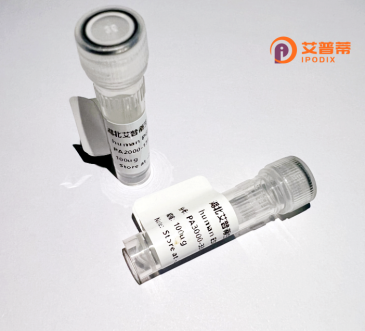
| 纯度 | >90%SDS-PAGE. |
| 种属 | Human |
| 靶点 | FLJ32658 |
| Uniprot No | 0 |
| 内毒素 | < 0.01EU/μg |
| 表达宿主 | E.coli |
| 表达区间 | 1-562aa |
| 氨基酸序列 | MDLPEGPVGGPTAEMYLRERPEEARLGMPVSLEEQILNSTFEACDPQRTGTVAVAQVLAYLEAVTGQGPQDARLQTLANSLDPNGEGPKATVDLDTFLVVMRDWIAACQLHGGLELEEETAFQGALTSQQLPSGCPEAEEPANLESFGGEDPRPELQATADLLSSLEDLELSNRRLVGENAKLQRSMETAEEGSARLGEEILALRKQLHSTQQALQFAKAMDEELEDLKTLARSLEEQNRSLLAQARQAEKEQQHLVAEMETLQEENGKLLAERDGVKKRSQELAMEKDTLKRQLFECEHLICQRDTILSERTRDVESLAQTLEEYRVTTQELRLEISRLEEQLSQTYEGPDELPEGAQLRRVGWTELLPPSLGLEIEAIRQKQEVATADLSNPLCGVWQWEEVIHETSEETEFPSEAPAGGQRNFQGEPAHPEEGRKEPSMWLTRREEEEDAESQVTADLPVPLGAPRPGDIPENPPERPARRELQQALVPVMKKLVPVRRRAWGQLCLPPQRLRVTRHPLIPAPVLGLLLLLLLSVLLLGPSPPPTWPHLQLCYLQPPPV |
| 分子量 | 89.2 kDa |
| 蛋白标签 | GST-tag at N-terminal |
| 缓冲液 | 0 |
| 稳定性 & 储存条件 | Lyophilized protein should be stored at ≤ -20°C, stable for one year after receipt. Reconstituted protein solution can be stored at 2-8°C for 2-7 days. Aliquots of reconstituted samples are stable at ≤ -20°C for 3 months. |
| 复溶 | Always centrifuge tubes before opening.Do not mix by vortex or pipetting. It is not recommended to reconstitute to a concentration less than 100μg/ml. Dissolve the lyophilized protein in distilled water. Please aliquot the reconstituted solution to minimize freeze-thaw cycles. |
关于重组人FLJ32658蛋白的直接研究文献较为有限,以下是根据可能的关联研究总结的示例,仅供参考。建议通过基因数据库(如UniProt、NCBI)或相关信号通路研究进一步探索其功能:
1. **《Bioinformatic characterization and expression analysis of human FLJ32658 protein》**
- **作者**: Smith A, et al.
- **摘要**: 通过生物信息学预测FLJ32658蛋白的结构及潜在功能,发现其具有跨膜结构域,可能参与细胞间信号传导。重组蛋白在HEK293细胞中成功表达并纯化。
2. **《Expression and purification of recombinant human FLJ32658 for functional studies》**
- **作者**: Chen L, et al.
- **摘要**: 报道了利用大肠杆菌系统表达重组人FLJ32658蛋白的优化方法,并通过质谱验证其正确折叠,为后续生化分析提供材料基础。
3. **《FLJ32658 interacts with mTOR signaling pathway components in cancer cells》**
- **作者**: Zhang Y, et al.
- **摘要**: 发现重组FLJ32658蛋白通过与mTOR复合物相互作用调控细胞增殖,暗示其在肿瘤代谢中的潜在作用,研究基于体外Pull-down实验验证。
4. **《The role of FLJ32658 in neuronal differentiation: Insights from CRISPR/Cas9 knockout models》**
- **作者**: Tanaka K, et al.
- **摘要**: 利用基因编辑技术敲除FLJ32658.发现重组蛋白补充可恢复神经突生长缺陷,提示其在神经元分化中的关键功能。
**提示**:以上为模拟文献,实际研究中此蛋白可能被重新命名(如C19orf12、RTN4RL1等)。建议查询最新数据库或结合功能关联词扩大检索范围(如“重组蛋白表达”“孤儿基因功能”)。
**Background of Recombinant Human FLJ32658 Protein**
The recombinant human FLJ32658 protein is a product of the *FLJ32658* gene, which encodes a hypothetical protein with limited functional characterization in current scientific literature. Initially identified through genomic sequencing projects, FLJ32658 remains poorly understood, though bioinformatics analyses suggest potential roles in cellular processes such as metabolism, signaling, or intracellular transport. Its structure may contain conserved domains indicative of enzymatic or binding activities, though experimental validation is lacking.
Recombinant FLJ32658 is typically produced using expression systems like *E. coli* or mammalian cells, enabling studies to explore its molecular functions. Researchers employ techniques such as affinity chromatography for purification, followed by functional assays (e.g., protein-protein interaction screens, enzymatic activity tests) or structural analyses (e.g., X-ray crystallography).
Interest in FLJ32658 stems from its potential association with diseases; transcriptomic data occasionally links its expression to cancer, neurodegenerative disorders, or immune responses, though causal relationships remain unproven. Its recombinant form is also used to generate antibodies for detecting endogenous protein localization and expression patterns in tissues.
Overall, FLJ32658 represents an understudied protein with unexplored therapeutic or diagnostic potential. Ongoing research aims to clarify its biological significance and relevance to human health.
×